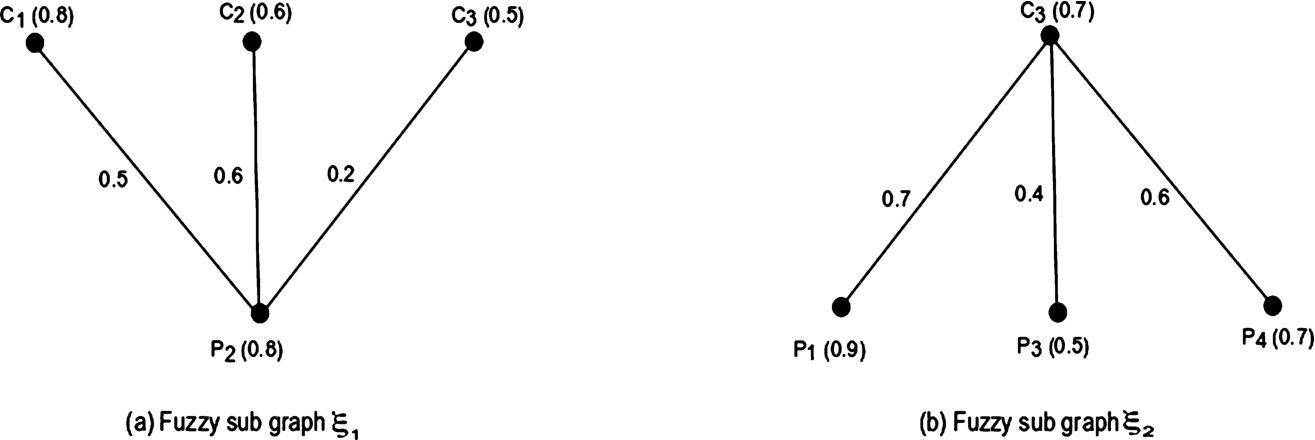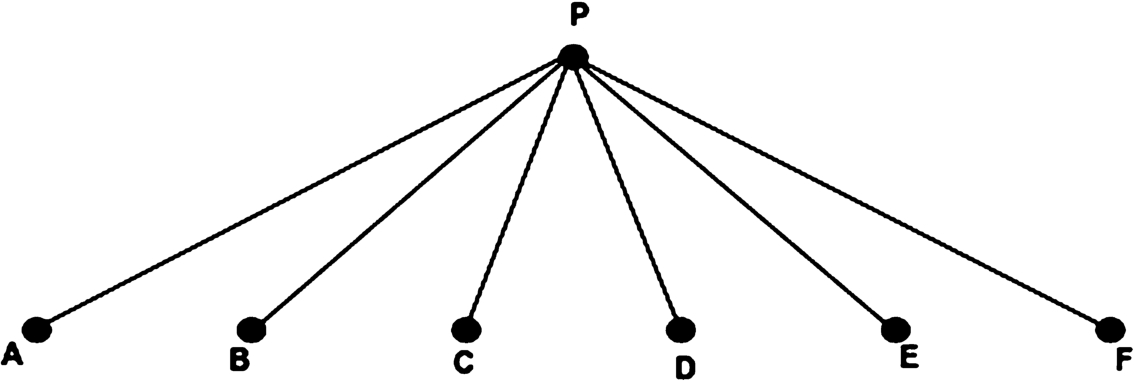Applications of Edge Colouring of Fuzzy Graphs
Abstract
Colouring of graphs is being used in several representations of real world systems like map colouring, traffic signalling, etc. This study introduces the edge colouring of fuzzy graphs. The chromatic index and the strong chromatic index are defined and related properties are investigated. In addition, job oriented web sites, traffic light problems have been presented and solved using the edge colouring of fuzzy graphs more effectively.
1Introduction
The concept of fuzzy graph, introduced by Kauffman (1973) initially, was interpreted by Rosenfeld (1975). Samanta and Pal (2015, 2013) introduced different types of fuzzy graphs. For further details about the fuzzy graphs, readers may see Mordeson and Nair (2000), Samanta et al. (2016a), Sarkar and Samanta (2017), Mahapatra et al. (2019a). Early in the literature, one of the useful problems, the traffic light problem, was solved using the crisp graph colouring technique. But, in traffic light problems, some routes are busier compared to the other routes. Also, sometimes, two routes are open simultaneously with some caution. Here “busy”, “caution” are fuzzy terms. So fuzzy/uncertainty could be included in the traffic light problem. Munoz et al. (2005) designed the traffic light problem by fuzzy graphs and introduced the method of colouring in fuzzy graphs. The edge colouring of fuzzy graphs could demonstrate the traffic light problem properly. The membership value of edges is calculated from the congestion of the route and the probability of accidents. If the signal lights are based on these membership values and used alongside the fuzzy colour, the density of the signal colours could indicate the flow of traffic in a particular region. In that paper, the fuzzy graphs were considered with crisp vertices and fuzzy edges. Then α-cuts Mordeson and Nair (2000) of these fuzzy graphs were coloured according to the method of the crisp graph colouring. Thus, for different values of α, there are different crisp graphs, and these crisp graphs are coloured. Therefore, the chromatic index varies for the same fuzzy graphs for different values of α. Also, Bershtein and Bozhenuk (2001) proposed a different technique to colour fuzzy graphs. In this paper, a term separation degree of fuzzy graphs has been defined and based on the value of separation degree, the number of minimum colour is found. Vertex colouring on fuzzy graphs is applied for map colouring Samanta et al. (2016b). Recently, major developments on chromatic index on fuzzy graphs are obtained from the papers of Rosyida et al. (2016, 2015) and Chen et al. (2017). Kishore and Sunitha Kishore and Sunitha (2014, 2016) introduced chromaticity and strong chromaticity of fuzzy graphs. Mahapatra et al. (2019b) advanced the colouring concept to radio fuzzy graphs and resolved radio frequency problems.
Sometimes, the relationship (edges) is more meaningful than the people (nodes). For example, the links in fuzzy social networks are more important than the nodes. Thus, it is essential to show the fuzzy links properly by colouring. Edge colouring, a related term, is important to the problems which are based on uncertainty. In Section 3 of this paper, edge colouring of fuzzy graphs is introduced. After that, in Section 4, chromatic index of fuzzy graphs, an associated term of graph colouring, is defined. Based on this technique, the number of basic colours is counted. In fuzzy graphs, edge colourings use colour density. Sometimes, deep/strong colours are to be used to emphasize the importance of the corresponding relation/edge. The definition of strong chromatic index is updated in Section 6. Here, a recruiting web site is represented from both companies’ and candidates’ point of view by edge colouring of fuzzy graphs in Section 6. Traffic light problems have been modified and solved in Section 7. At last, a conclusion is drawn in Section 8.
2Preliminaries
A graph is defined as a pair
A fuzzy set A on a universal set X is characterized by a mapping
A fuzzy graph Rosenfeld (1975)
A path in a fuzzy graph is a sequence of distinct nodes
The strength of a path is the minimum membership value of an edge in the path. The maximum of all strengths of paths between two vertices is the strength of connectivity between the vertices.
The underlying crisp graph of the fuzzy graph
A fuzzy graph
A fuzzy graph
3Edge Colouring of Fuzzy Graphs
Samanta et al. (2016b) defined fuzzy colours as mixed colours. But when a colour is mixed with white, its intensity is reduced. Now, intensity is a fuzzy term. Suppose β
Definition 1.
Let
Hence, the colour
According to the above definition of fuzzy colour, different fuzzy colours are constructed from a basic colour. For example, red is a basic colour. A “fuzzy red” colour may be formed from red by mixing 0.9 units of red colour with 0.1 units of white colour. This “fuzzy red” colour is denoted by
3.1Procedure of Edge Colouring of Fuzzy Graphs
In crisp graph colouring, two edges have different colours if they are adjacent. Otherwise, the colour may be the same. In fuzzy edge colouring, two edges have fuzzy colours whose basic colours are different, if they are adjacent. Otherwise, their fuzzy colours may be the same and from the same basic colour.
Let
3.2Algorithm to Colour the Edges of a Fuzzy Graph
Input: A fuzzy graph
Output: Complete a edge coloured graph.
Step 1: Calculate
Step 2: First of all, the vertex “1” is focused to colour all its incident edges in such a way that no two incident edges are of the same colours. Here, depths of the colours depend on the
Step 3: Proceed to direct neighbours of “1” except the previous one which is already focused and label them
Step 4: Repeat Step 3 until all edges of the graph have been coloured.
4Chromatic Index of Fuzzy Graphs
The minimum number of basic colours needed to colour a fuzzy graph is called fuzzy chromatic index of a fuzzy graph. Suppose that such minimum number of basic colours is N. Now, this crisp chromatic index is not sufficient to mention the strengths of edges (i.e. the relationship among vertices). For example, chromatic indexes of two fuzzy graphs are the same. Then it is inconclusive when these graphs are being compared. Hence, the chromatic index is associated with some weight. The weight is denoted by W, and defined by
4.1Algorithm of Minimum Colouring of Edges of a Fuzzy Graph
Input: A fuzzy graph
Output: Complete a edge coloured graph.
Step 1: Now, f-value (
Step 2: First of all, the vertex “1” is targeted to colour all its incident edges in such a way that the minimum number of colours would be used. Hence, if one colour is used, a different colour is to be used only if the edges are incident to the vertex.
Step 3: Proceed to direct neighbours of “1” except the previous one which is already focused and label them
Step 4: Repeat Step 3 until all edges of the graph have been coloured.
Formally, the definition of chromatic index for fuzzy graphs is given as follows. The concept of this chromatic index will allow to mention the weight of edge colouring.
Definition 2.
Let
The chromatic index on fuzzy graphs is a pair whose first element represents the crisp chromatic index, and the second element is its weight. The crisp number indicates only the number of different colours required to colour the edges of a graph while the weight represents the sum of strengths of the edges. This weight is meaningful only when it is of a very high or very low value, i.e. all edges are strong, or all edges are weak. Thus, the weight needs further restrictions.
Example 1.
An example is considered in Fig. 1. In this example, three basic colours (red, black and green) are used for the colouring of the fuzzy graph, i.e.
Fig. 1
Edge colouring of fuzzy graphs.
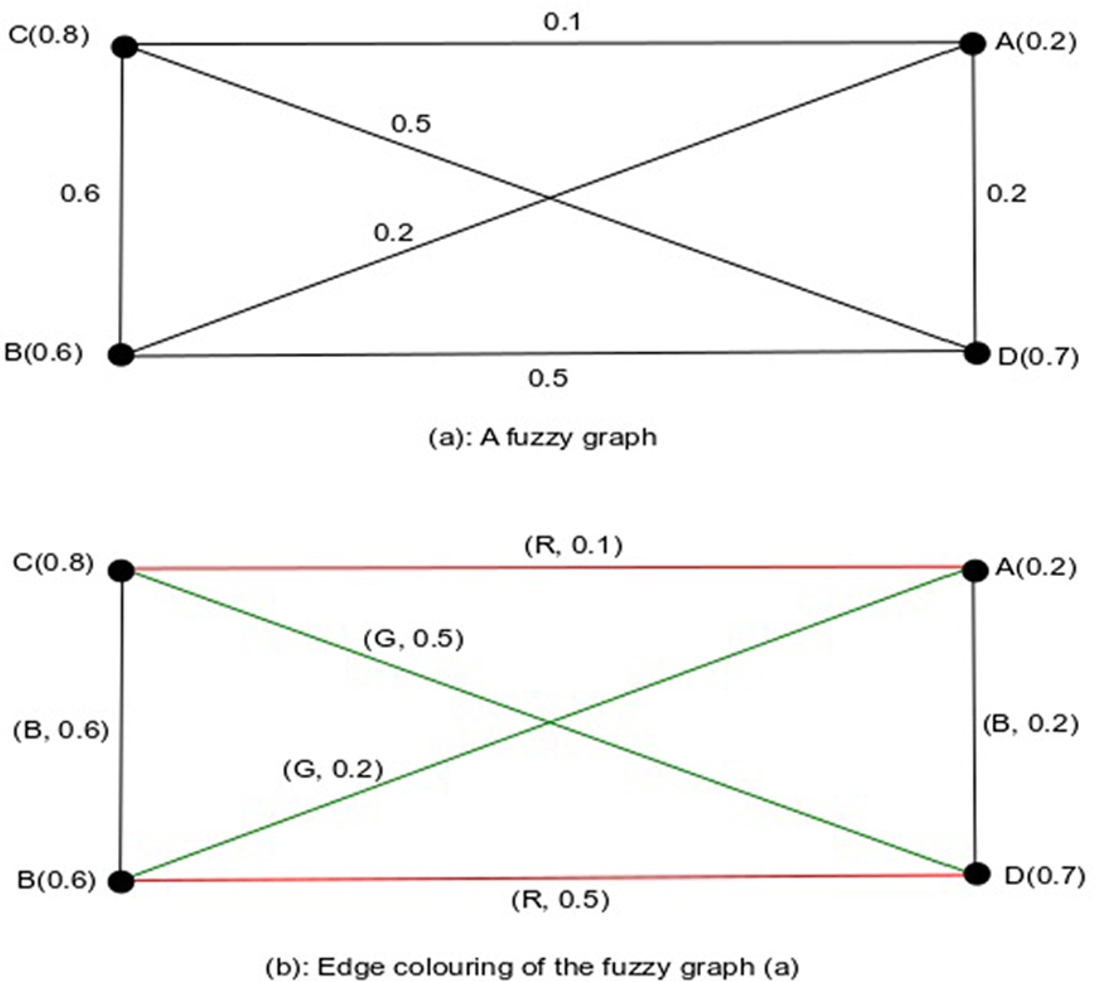
Lemma 1.
Chromatic index of a complete graph is
Proof.
Let
Lemma 2.
If the chromatic index of a fuzzy graph is
Proof.
Let
5Strong Chromatic Index of Edge Colouring of Fuzzy Graphs
The weight of the chromatic number is significant only if the weight is very large or very small. Suppose that two fuzzy graphs have chromatic indexes which are
Example 2.
Let us consider a fuzzy graph shown in Fig. 2. Here, four basic colours (red, yellow, green and blue) are used for the colouring of the fuzzy graph. The membership values of the colours are 0.8, 0.25, 0.33, 1, respectively. Therefore,
Fig. 2
Colouring of strong edge of fuzzy graphs.

Theorem 1.
Let ξ be a fuzzy graph, and the chromatic index of this fuzzy graph is
Proof.
Let
Again, some of the basic colours are considered strong. However, there exist some basic colours which are not strong, i.e.
Lastly, none of the basic colours is strong. In this case
Lemma 3.
Let ξ be a fuzzy graph with a strong chromatic index
Proof.
Let
Theorem 2.
Let ξ be a fuzzy graph with a strong chromatic index
Proof.
Let
Lemma 4.
Let ξ be a fuzzy graph other than complete fuzzy graphs with a chromatic index
Proof.
Let ξ be a fuzzy graph other than complete fuzzy graphs with a chromatic index
Hence,
Lemma 5.
Let ξ be a fuzzy cycle with a chromatic index
Proof.
If the fuzzy cycle has an even number of edges, then to colour this cycle, only two basic colours are needed. So,
Hence,
If the fuzzy graph has an odd number of edges, then for this cycle three basic colours are needed. So
Note 1.
Let ξ be a bipartite fuzzy graph and Δ be the maximum degree of this fuzzy graph, then its chromatic index is
Theorem 3.
Let ξ be a fuzzy graph with vertex membership values 1 and
Proof.
Suppose ξ is a fuzzy graph with vertex membership values 1 and
In case of upper bound, the minimum number of colours required to colour a fuzzy cycle of 3 vertices is
6Representation of Job Oriented Web Sites by Edge Colouring of Fuzzy Graphs
Fuzzy graph colouring problem has various practical applications. One of them is in job oriented web sites. Job oriented web sites are useful in recent years. A lot of recruiters and job seekers gather in these web sites. Fuzzy graphs represent each web site. The following example shows a step by step method of representation of web sites and edge colouring of fuzzy graphs. By looking at the colour of a fuzzy graph, an applicant could understand how many companies suit his/her expertise. Furthermore, on the other side, a company finds a suitable applicant. Thus, the representation of job oriented web sites can be prepared in an easier way using the edge colouring of fuzzy graphs.
Let us assume such a small web site, where N number of candidates are registered for jobs with their Bio-Data, and M number of companies (recruiters) have registered a certain number of vacancies and the brand value of the company for appropriate candidates (see Fig. 3).
If an applicant’s eligibility suits a company’s demand, it is obvious that there exists a relation between them. Here, the companies and candidates are represented as vertices and their links as edges. Now, the membership values of corresponding vertices of the company may depend on the following issues:
(1) Salary;
(2) Company brand value;
(3) Product value;
(4) Job security;
(5) Medical benefits;
(6) Car benefits;
(7) Insurance benefits;
(8) Accommodation benefits;
(9) Service rule;
(10) Service hours;
(11) Job responsibility.
(1) Academic qualification;
(2) Experience;
(3) Language;
(4) Communication skill;
(5) Age;
(6) Salary requirement;
(8) Compensation;
(9) Behaviour.
The membership values of edges depend on matching the companies’ profiles with the applicants’ profiles. Then, the relationship between companies and applicants is shown as a fuzzy bipartite graph, shown in Fig. 5. If a company wants to find suitable candidates, firstly, it logins into this web site, then it will get a fuzzy subgraph like Fig. 3. The company may shortly find suitable candidates by using the concept of strong chromatic index.
Fig. 3
Representation of companies and applicants in a job oriented web site.
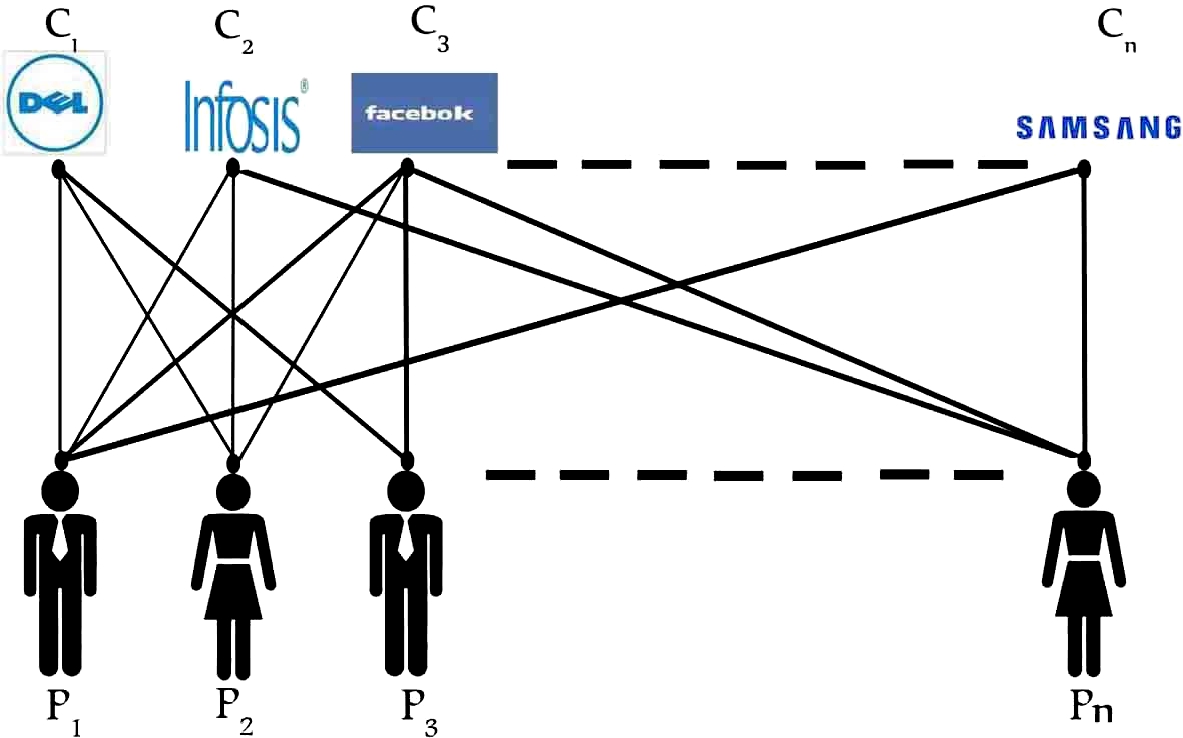
Suppose, in particular, 5 companies and 4 applicants are registered on this job oriented web site (see Fig. 5). Thus, a fuzzy bipartite graph is considered where the vertices are the companies
For example, in a particular case, the membership values of vertices
When a company or an applicant logins into this web site, then they get a fuzzy subgraph like Fig. 5. Particularly, if an applicant
Fig. 4
Fuzzy sub graph for the vertex
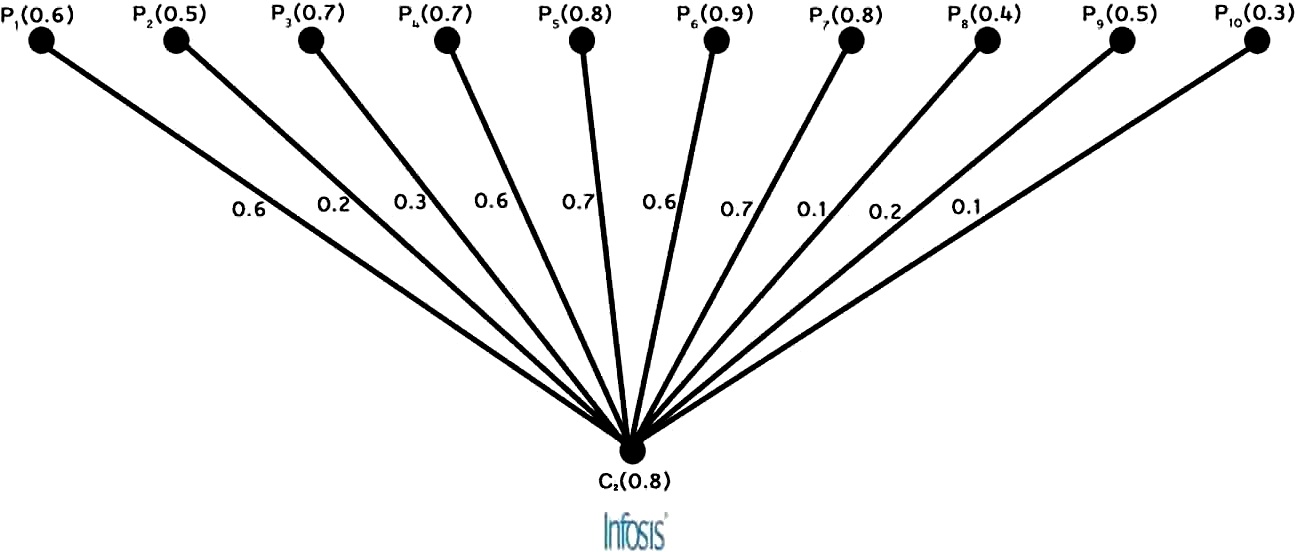
Fig. 5
Fuzzy graph of the job oriented web site.
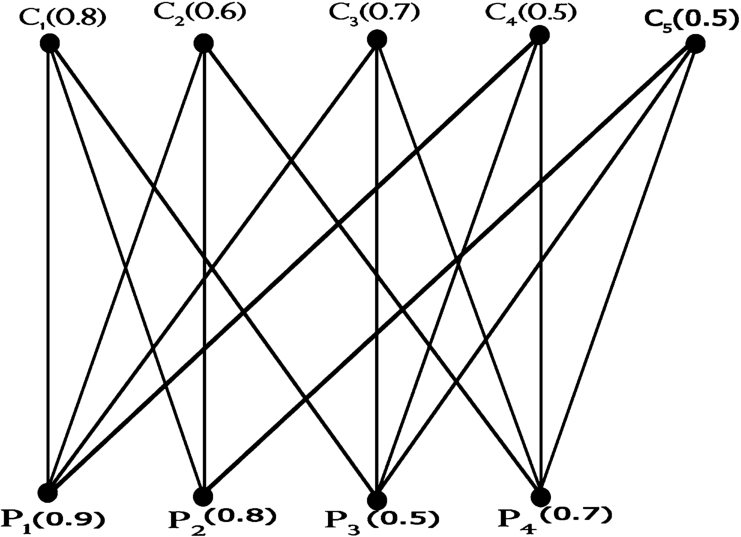
If these two fuzzy subgraphs are coloured by fuzzy colours, then the applicant
A company (say Infosis) wants to find suitable candidates. Then after login, it gets a fuzzy subgraph (Fig. 3). Suppose this company finds 10 applicants (see Fig. 4) and the number of vacancies is 2. If the company wants to call top suitable candidates for the test, then the company must use the strong chromatic index. The strong chromatic index is
From the chromatic index an applicant can realise how many companies are suitable for his/her recruitment and from the weight he/she can understand the chance of recruitment. And from the colour density of the fuzzy graph he understands which company is the best for him. Also, from the strong chromatic index it can be determined how many companies can select him.
Similarly, when a company logins, it gets a coloured fuzzy subgraph shown in Fig. 7(b). From the chromatic index and the strong chromatic index, it gets how many candidates are suitable for the company, and from the weight, it gets the deserved candidates.
Fig. 7
Edge colouring of the fuzzy sub graphs.

Fig. 8
CCTV for collection of data.
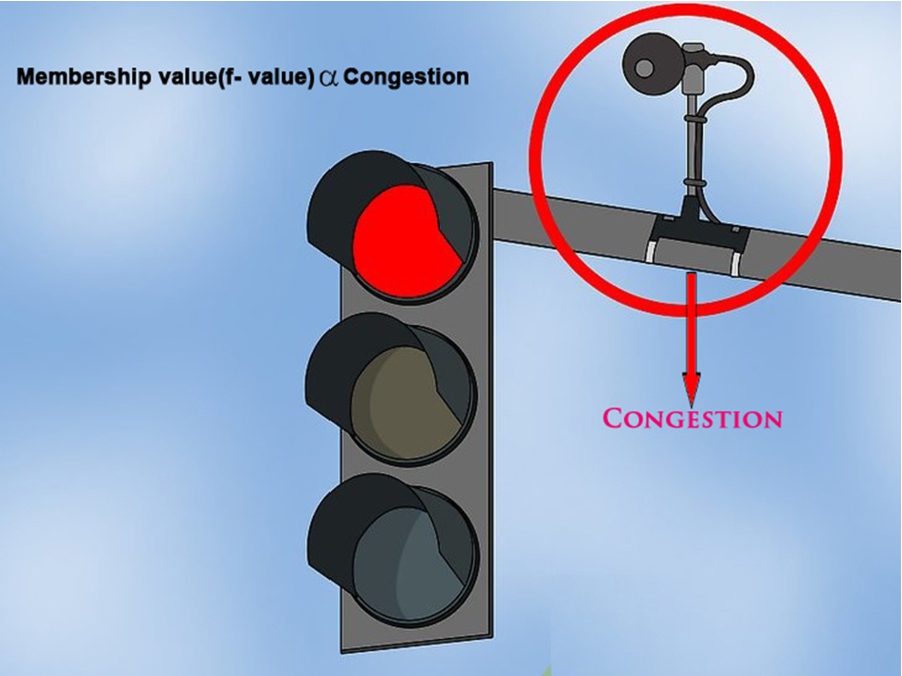
7Representation of Traffic Light Problem
One of the most useful real life applications of the edge colouring is in traffic light problems. Traffic light system uses three standard colours: red, amber (yellow), green, following the universal colour code. The green light allows traffic to proceed in the denoted direction. The amber (yellow) light warns that more precautions should be taken to cross the road. The red signal prohibits any traffic from proceeding. However, in the present traffic light system, a traveller does not know how much the traffic is congested. This limitation has to be removed here. Traffic light system will be modified by the edge colouring of fuzzy graphs.
It takes every route as a fuzzy vertex. An edge between two vertices is drawn if the routes have a junction. The edge membership values are calculated based on the congestion of routes and the road condition. The data is collected from real time CCTV (see Fig. 8).
Thus a fuzzy graph
Now, a seven point crossing (for example, Park circus seven point crossing, Kolkata, West Bengal, India, see Fig. 9) is taken as an example. The image is collected from Google Maps. This picture is converted into a fuzzy graph (see Fig. 10). Now, the membership value of the edges in the figure PA, PB, PC, PD, PE, PF, AB, AF, AE, AD, AC, BC, BD, BE, BF, CD, CE, CF, DE, DF, EF are calculated from real time CCTV showing the road conjunction and the road condition. A traveller from P road can visit any route of this crossing if all routes are open at that time. So a fuzzy subgraph can be constructed against the node P to represent the travellers possible visit, whose edges are PA, PB, PC, PD, PE, PF (see Fig. 11).
Fig. 9
Seven point crossing park circus, Kolkata (collected from Google Map).
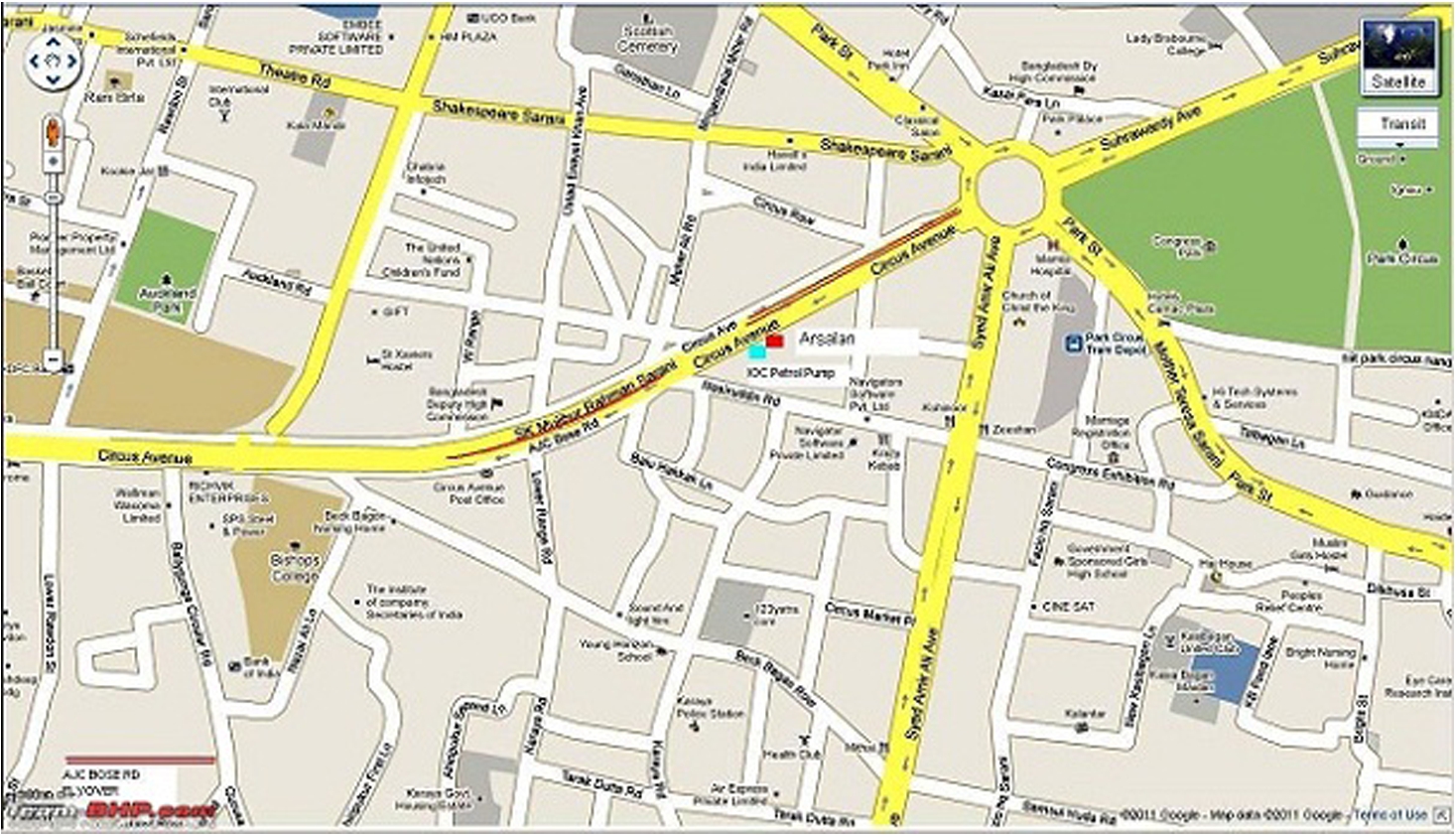
Fig. 10
Fuzzy graph of seven point crossing.
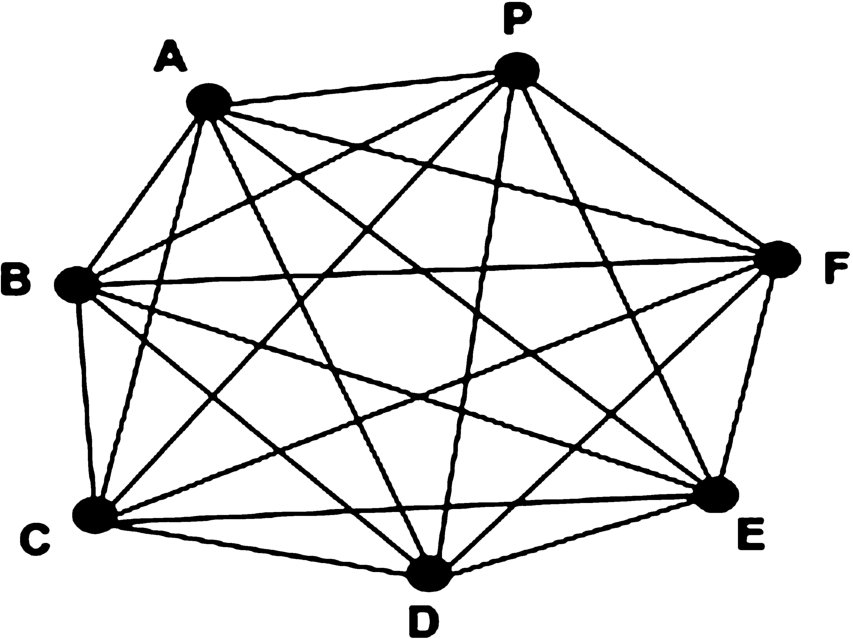
Fig. 12
Edge colouring of fuzzy graph.
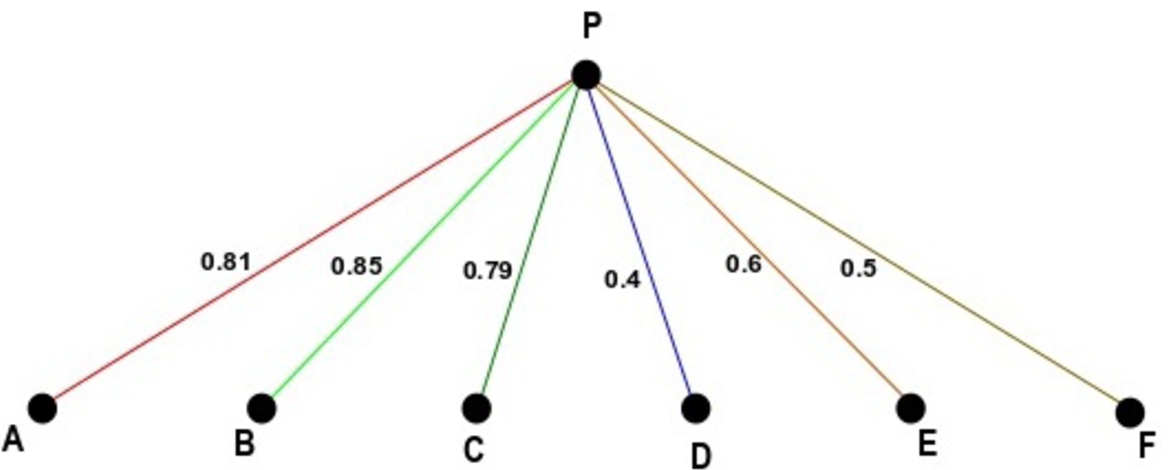
Let us consider at a particular time the membership value of the edges PA, PB, PC, PD, PE, PF be
When a traveller is travelling the P road, it would be helpful, if all the information about the next crossing was displayed in two or three display boards before the crossing. From the chromatic index the traveller can understand how many roads are open at the time of crossing, and from the weight, the total traffic condition. For this purpose, the congestion of the next crossing is to be represented in terms of percentage. Here, f-value, i.e. 0.81 indicates that the congestion is
Fig. 13
Red signal with percentage of mixing of colours.
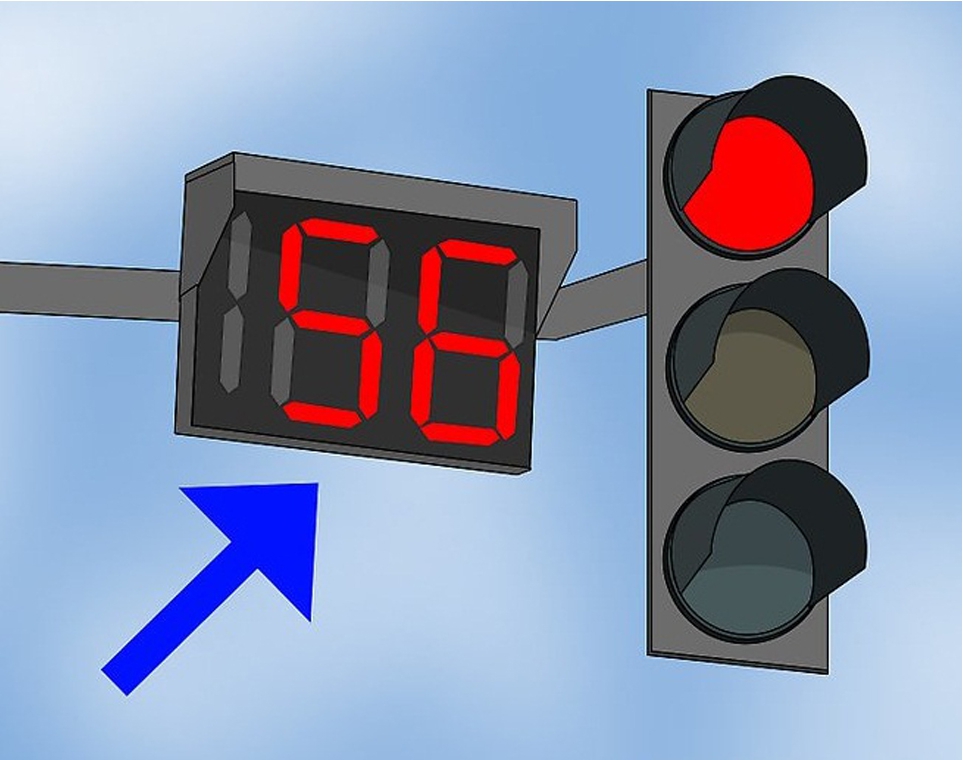
Also we can use this depth of colour in red (
The stopping time can be fixed with the help of the membership value of the red signal. If the membership value of the red colour is increased, then the stopping time will decrease.
8Conclusion
In this study, a concept of edge colouring has been introduced. A related term, chromatic index, is also defined in a different way. A weight is associated with each of the chromatic indexes. This weight might be defined in different ways. But the proposed method mentions the depth of the colours to be used to colour a graph. At the end of this paper, the traffic light problem is updated. In that problem, if the subgraph is uploaded for online traffic condition, then the input graph will be compatible with Google Traffic indicating system. It is seen that Google Traffic system calculates the data from the flow of mobiles. But here, membership values are calculated from real-time CCTV. Google Traffic uses three or four colours to represent the condition of the traffic, but the proposed method uses the colour density with a percentage, which is much more helpful to the traveller. Thus, a user can easily understand the present condition of the traffic. There are many real field problems which can be solved using this technique of colouring, such as transportation problems, social networking problems, sport modelling. The proposed method may be implemented empirically in the existing traffic light systems. The theoretical approach of edge colouring will be beneficial to other graph colouring problems as well. In future studies, more uncertainty may be represented through generalized fuzzy graphs.
References
1 | Bershtein, L.S., Bozhenuk, A.V. ((2001) ). Fuzzy coloring for fuzzy graphs. In: lEEE International Fuzzy Systems Conference, pp. 1101–1103. |
2 | Chen, L., Peng, J., Zhang, B., Li, S. ((2017) ). Uncertain programming model for uncertain minimum weight vertex covering problem. Journal of Intelligent Manufacturing, 28: (3), 625–632. |
3 | Kauffman, A. ((1973) ). Introduction a la Theorie des Sous-emsembles Flous. Masson et Cie Editeurs, Paris. |
4 | Kishore, A., Sunitha, M.S. ((2014) ). Strong chromatic number of fuzzy graphs. Annals of Pure and Applied Mathematics, 7: , 52–60. |
5 | Kishore, A., Sunitha, M.S. ((2016) ). On Injective Coloring of Graphs and Chromaticity of Fuzzy Graphs. LAP Lambert Academic Publishing. |
6 | Mahapatra, R., Samanta, S., Pal, M., Qin, X. ((2019) a). RSM index: a new way of link prediction in social networks. Journal of Intelligent and Fuzzy Systems, 37: , 2137–2151. https://doi.org/10.3233/JIFS-181452. |
7 | Mahapatra, R., Samanta, S., Allahviranloo, T., Pal, M. ((2019) b). Radio fuzzy graphs and assignment of frequency in radio stations. Computational and Applied Mathematics. https://doi.org/10.1007/s40314-019-0888-3. |
8 | Mordeson, J.N., Nair, P.S. ((2000) ). Fuzzy Graphs and Hypergraphs. Physica Verlag. |
9 | Munoz, S., Ortuno M, T., Ramirez, J., Yanez, J. ((2005) ). Coloring fuzzy graphs. Omega, 33: (3), 211–221. |
10 | Rosenfeld, A. ((1975) ). Fuzzy graphs. In: Zadeh, L.A., Fu, K.S., Shimura, M. (Eds.), Fuzzy Sets and Their Applications. Academic Press, New York, pp. 77–95. |
11 | Rosyida, I., Widodo, Indrati, C.R., Ariyanti, K., ((2015) ). A new approach in determining fuzzy chromatic index of a fuzzy graph. Journal of Intelligent and Fuzzy Systems, 28: (5), 2331–2341. |
12 | Rosyida, I., Peng, J., Chen, L., Widodo, I.C.R., Sugeng, K.A. ((2016) ). An uncertain chromatic index of an uncertain graph based on alpha-cut coloring. Fuzzy Optimization and Decision Making. https://doi.org/10.1007/s10700-016-9260-x. |
13 | Samanta, S., Pal, M. ((2013) ). Fuzzy k-competition graphs and p-competition fuzzy graphs. Fuzzy Engineering and Information, 5: (2), 191–204. |
14 | Samanta, S., Pal, M. ((2015) ). Fuzzy planar graphs. IEEE Transaction on Fuzzy Systems, 23: (6), 1936–1942. |
15 | Samanta, S., Sarkar, B., Shin, D., Pal, M. ((2016) a). Completeness and regularity of generalized fuzzy graphs. Springer Plus. https://doi.org/10.1186/s40064-016-3558-6. |
16 | Samanta, S., Pramanik, T., Pal, M. ((2016) b). Colouring of fuzzy graphs. Afrika Matematica, 27: , 37–50. |
17 | Sarkar, B., Samanta, S. ((2017) ). Generalized fuzzy trees. International Journal of Computational Intelligence Systems, 10: , 711–720. |

